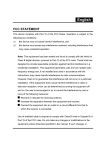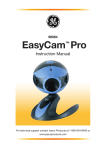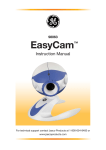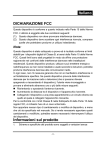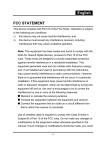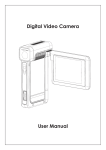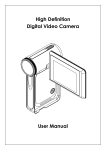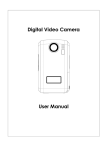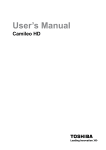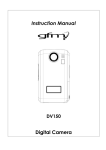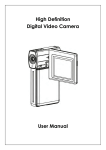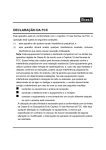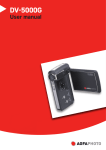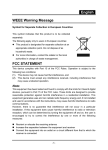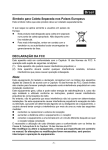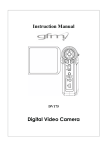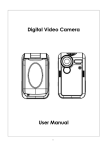Download English WEEE Warning Message FCC STATEMENT
Transcript
English WEEE Warning Message Symbol for Separate Collection in European Countries This symbol indicates that this product is to be collected separately. The following apply only to users in European countries: z This product is designated for separate collection at an appropriate collection point. Do not dispose of as household waste. z For more information, contact the retailer or the local authorities in charge of waste management. FCC STATEMENT This device complies with Part 15 of the FCC Rules. Operation is subject to the following two conditions: (1). This device may not cause harmful interference, and (2). This device must accept any interference received, including interference that may cause undesired operation. Note: This equipment has been tested and found to comply with the limits for Class B digital devices, pursuant to Part 15 of the FCC rules. These limits are designed to provide reasonable protection against harmful interference in a residential installation. This equipment generates uses and can radiate radio frequency energy and, if not installed and used in accordance with the English instructions, may cause harmful interference to radio communications. However, there is no guarantee that interference will not occur in a particular installation. If this equipment does cause harmful interference to radio or television reception, which can be determined by turning the equipment off and on, the user is encouraged to try to correct the interference by one or more of the following measures: Reorient or relocate the receiving antenna Increase the separation between the equipment and receiver Connect the equipment into an outlet on a circuit different from that to which the receiver is connected Use of shielded cable is required to comply with Class B limits in Subpart B of Part 15 of the FCC rules. Do not make any changes or modifications to the equipment unless otherwise specified in the manual. If such changes or modifications should be made, you could be required to stop operation of the equipment. Product Information 1.Product design and specifications are subject to change without notice. This includes primary product specifications, software, software drivers, and user’s manual. This User Manual is a general reference guide for the product. 2.The product and accessories that come with your camera may be different from those described in this manual. This is due to the fact that different retailers often specify slightly different product inclusions and accessories to suit their market requirements, customer demographics, and geographical preferences. Products very often vary between retailers especially with accessories such as batteries, memory cards, cables, English carrying cases/pouches, and language support. Occasionally a retailer will specify a unique product color, appearance, and internal memory capacity. Contact your dealer for precise product definition and included accessories. 3.The illustrations in this manual are for the purpose of explanation and may differ from the actual design of your camera. 4.The manufacturer assumes no liability for any errors or discrepancies in this user manual. 5.For driver updates, you can check the “Download” section of our website, www.geniusnet.com SAFETY INSTRUCTIONS Read and understand all Warnings and Cautions before using this product. Warnings If foreign objects or water have entered the camera, turn the power OFF and remove the batteries. Continued use in this state might cause fire or electric shock. Consult the store of purchase. If the camera has fallen or its case has been damaged, turn the power OFF and remove the batteries. Continued use in this state might cause fire or electric shock. Consult the store of purchase Do not disassemble, change or repair the camera. This might cause fire or electric shock. For repair or internal inspection, ask the store of purchase. Do not use the camera in areas near water. This might cause fire or electric shock. Take special care during rain, snow, on the beach, or near the shore. English Do not place the camera on inclined or unstable surfaces. This might cause the camera to fall or tilt over, causing injury. Keep the batteries out of the reach of children. Swallowing batteries might cause poisoning. If the battery is accidentally swallowed, immediately consult a physician. Do not use the camera while you are walking, driving or riding a motorcycle. This might cause you to fall over or result in traffic accident. Cautions Insert the batteries paying careful attention to the polarity (+ or –) of the terminals. Inserting the batteries with its polarities inverted might cause fire and injury, or damage to the surrounding areas due to the battery rupturing or leaking. Do not fire the flash close to anyone’s eyes. This might cause damage to the person’s eyesight. Do not subject the LCD monitor to impact. This might damage the glass on the screen or cause the internal fluid to leak. If the internal fluid enters your eyes or comes into contact with your body or clothes, rinse with fresh water. If the internal fluid has entered your eyes, consult a physician to receive treatment. A camera is a precision instrument. Do not drop it, strike it or use excessive force when handling the camera. This might cause damage to the camera. Do not use the camera in humid, steamy, smoky, or dusty places. This might cause fire or electric shock. Do not remove the battery immediately after long period of continuous use. The battery becomes hot during use. Touching a hot battery might cause burns. English Do not wrap the camera or place it in cloth or blankets. This might cause heat to build up and deform the case, resulting in fire. Use the camera in a well-ventilated place. Do not leave the camera in places where the temperature may rise significantly, such as inside a car. This might adversely affect the case or the parts inside, resulting in fire. Before you move the camera, disconnect cords and cables. Failure to do this might damage cords and cables, resulting in fire and electric shock. Notes on Battery Usage When you use the battery, carefully read and strictly observe the Safety Instructions and the notes described below: Different battery types and surrounding temperatures may affect the battery performance. Avoid using batteries in extremely cold environments as low temperatures can shorten the battery life and reduce camera performance. The battery may feel warm when using the camera for an extended period of time or using the flash continuously. This is normal and not a malfunction. The digital video camera may feel warm when being used continuously or for an extended period of time. This is normal and not a malfunction. If you will not be using the batteries for an extended period of time, remove them from the camera to prevent leakage or corrosion. Always keep the terminals in a clean state. Never use manganese batteries. Risk of explosion if battery is replaced by an incorrect type. Dispose of used batteries according to the instructions. English Content Section 1 Getting to Know Your Digital Video 1-4 Camera Overview Standard Accessories Front View KeyPad illustration Side View Section 2 Getting Up and Running 5-7 Loading the Battery Inserting and Removing a SD Card(Optional) Protecting Data on an SD Card Turning the Digital Video Camera On and Getting Started Turning the Digital Video Camera off Section 3 Record Mode 8-48 Record Mode Button Function Option Function LCD Monitor Information MPEG-4 Movie Recording Picture Recording Voice Recording Taking Close up Pictures Using Digital Zoom Options for Record Mode Operations for Record Mode Default Setting and Validation Record Submenu Setting Movie Resolution Exposure Sharpness White Balance Motion Stabilization Motion Detection Camera Mode Picture Resolution Exposure Two in One (Picture Record Mode Only) Photo Frame (Picture Record Model Only) Self-timer (Picture Record Mode Only) Sharpness White Balance Multi-Snap (Picture Record Mode Only) Backlight (Picture Record Mode Only) Date Printing English Voice Mode Effect Setting Setting Menu Sound Setting Start-Up Screen Time Setting Format Card TV System Selecting Interface Language Default Setting Section 4 Playback Mode 49-67 Button Functions LCD Monitor Information Movie Playback Delete Movies Thumbnail Function Lock Movies Repeat Movies Picture Playback Delete Picture Thumbnail Function Lock Pictures Make Slide Show Voice Playback Direction buttons Function Section 5 Listening to MP3 Music MP3 Music 68-71 Transfer MP3 Music to the Digital Video Camera Listen to MP3 Music Listen to MP3 Music with earphone Section 6 Viewing MPEG-4 Movie 72-74 on PC MPEG-4 Movie View MPEG-4 Movie on PC Share MPEG-4 Movie Section 7 Viewing Pictures and 75-76 Movies on a TV Section 8 Transferring Data to a Computer 76 Section 9 Video File 77-82 Converter Section 10 Burning the Recorded Clip 83-86 into DVD Section 11 Transferring Data to a 87-97 Computer Installing the Data to a Computer English Connecting Your Digital Video Camera to a Computer Mass Storage Device Mode PC Cam Mode Installing Bundled Software Getting Started With Photo Express 5.0 Getting Started With Video Studio 8.0 Section 12 Specifications and System 99-100 Requirements Specifications System Requirements English Section 1 Getting to Know Your Digital Video Camera Overview The camera with 3.2 Mega Pixel sensor can take DVD-Quality MPEG-4 movies. By way of using MPEG-4 technology, more videos can be taken within certain amount of memory. High quality images with up to 10 mega-pixels can also be delivered smoothly. With a color LCD monitor, users can compose images and examine them easily. Exposure and color balance can either be adjusted automatically or allowed to be changed manually. An 8x digital zoom increases user control over the movies and pictures you take. The camera is also ideally suited for using as a PC camera hooked up to your home computer via a high speed USB 2.0 port Build in 64 MB memory allows you to take pictures and movies without a memory card. The memory card slot allows users to increase the storage capacity up to 2GB. -1- English NOTE Partial memory of the built-in 32MB memory is used for Firmware code Standard Accessories Unpack the package and make sure all standard accessories listed are included: z Camera z USB Cable z TV out Cable z Two AA (Alkaline) Batteries z Quick Guide z CD-ROM ( Driver, Ulead Software and User Manual) z Earphone z Strap z Pouch NOTE Accessory and components may vary by different retailer. -2- English Front view 1. 2. 3. 4. A. Lens Flash Self-timer LED Power Button SD card slot KeyPad illustration 1. TFT LCD 2. Direction Buttons 3. Picture Shutter Button 4. Movie Shutter Button 5. Tele-Wide Button 6. RECORD/PLAY Button 7. TV out/Earphone Port 8. USB 2.0 Port -3- English Side View 1. Speaker 2. Battery Cover 3. Macro Switch 4. Microphone -4- English Section 2 Getting Up and Running Loading the Battery Before using the camera, end users must load two AA (Alkaline) batteries. 1. Follow the arrow direction and slide to eject the battery cover. 2. Insert the batteries according to the correct polarity marks ( + or -) 3. Close the battery cover firmly. Inserting and Removing an SD Card (Optional) The camera comes with internal memory which allows you to store pictures, movies, voice recordings and music. You can expand the memory capacity by using an optional SD or MMC memory card up to 2GB. To insert a memory card, refer to the figure as below: -5- English 1. Insert the memory card into the right position. 2. To remove an installed SD card, press the card inwards to release it. 3. When the card pops out, gently remove it from its slot. NOTE When a memory card, you use a movies and pictures are saved on card rather than on the built-in memory. Protecting Data on an SD Card The SD card is read-only by locking the SD card. No pictures, movies and voice can be recorded when the SD card is locked. Make sure the lock is in writeable position before recording any media. To prevent valuable data from being accidentally erased from an SD memory card you can slide the write-protected tab (on the side of the SD memory card) to “LOCK”. Please format an SD memory card by this Digital Video Camera before use. -6- English Turning the Digital Video Camera On and Getting Started To turn on the camera: (1) Flip out the LCD panel; the camera will turn on automatically. (2) When the Digital Video Camera is turned on, the green LED will light up. (3) Or press Power Button for one second to turn on it. Ö To take a movie, press the Movie Shutter Button ( Ö To take a picture, press the Picture Shutter Button ( Ö To record the voice, press the Upper Button of Direction Buttons and press the Movie Shutter Button ( Ö ). ). ) to start voice recording. To view stored movies, pictures, listen to stored MP3 and voice recordings, or read eBook, press RECORD/PLAY Button once to switch to Playback Mode. Press a second time to return to Record Mode. Turning the Digital Video Camera off 1. To turn off the Digital Video Camera, you can either press or hold the [Power] Button for one second, or you can place the panel back to its original position. 2. If no operation is made in 3 minutes, the digital video camera will turn itself off automatically to conserve battery power. -7- English Section 3 Record Mode Record Mode Button Function 1. Right Button : Flash AUTO/OFF 2. Left Button :Self-Timer ON/OFF 3. Up Button : Voice Recording Mode 4. Down Button: LCD Information ON/OFF 5. Enter Button : Menu ON Power Button: Press down for one second to turn on or turn off the camera. RECORD/PLAY Button functions: 1. Switch between Record /Playback Mode. 2. Return to the previous page. Tele-Wide Button: Digital Zoom in and out. Movie Shutter Button: 1. Start to take movie, or record voice. 2. To stop recording, press it again. -8- English Picture Shutter Button: Start to take picture Macro switch: Switch between Macro Mode, Portrait Mode, and Normal Mode. Option Function Movie Mode Resolution High 640 x 480 (1.8 Mbps) Std 640 x 480 (1 Mbps) 320 x 240 (500 Kbps) Low +1.0EV +0.6EV Select one of the 7 exposure +0.3EV 0EV compensation values (-1.0 to + Exposure -0.3EV -0.6EV 1.0EV -1.0EV Adjust with nine sharpness settings to soften or Sharpness sharpen picture/movie. Automatic adjustment Auto -9- English Auto Automatic adjustment Daylight Use under outsides light condition Use under fluorescent light condition White Balance Fluorescent Tungsten On Motion Stabilization Motion Detect User under tungsten light condition Corrects camera shake instantly, giving you smooth and stable video. off Disables motion stabilization On Start to record video while detecting movement of object(s). off Disable motion detection. Camera Mode Resolution Exposure High 3744 x 2808 (10M pixel) Std 2048 x 1536 (3 M pixel) 1024 x 768 (800K pixel) Low +1.0EV +0.6EV Select on of the 7 exposure +0.3EV 0EV compensation values (-1.0 to + -0.3EV -0.6EV 1.0EV -1.0EV -10- English On Combines two snapshots into one frame off Disables Two in One Two in One Mode Photo Frame Adds photo frame to the picture The flash fires automatically according to the scenic light condition. Auto Flash On The flash will not fire in any light condition. Activates 10-second-delayed Self-Timer. Off Disables Self-Timer Off Self-Timer Mode Adjust with nine sharpness settings to soften or Sharpness sharpen picture/movie. Auto Automatic adjustment Daylight Use under outside light condition Use under fluorescent light condition White Balance Fluorescent User under tungsten light condition Takes 5 continuous pictures at one time Tungsten Multi-Snap On -11- English Off Disables Multi-Snap On Brightens the object when its background is much brighter than the object. Off Disables Backlight mode On Imprints the date on picture. Off Disables Date Printing Backlight Date Printing Voice Pen Enter Exit Enters the voice recording section Exits the menu. Effect Normal No special effects applied to the picture. B/W Picture is converted to black-and-white. Classic Sepia look is applied to the image. Negative The image is converted as the negative of the normal. -12- English SET Setting Sound On: Enable operation sound Off: Disable operation sound Start-up Screen Customize Startup Screen Time Setting Setup Date and Time Format Card YES: Format SD card NO: Do not format SD card TV output setting is NTSC standard TV System TV output setting is PAL standard Language English, Brazil Portuguese, German, Italian, Spanish, Russian and Traditional Chinese. Default Setting Yes: Restore default factory setting No: Do not restore default factory setting LCD Monitor Information The indicators shown below may display on LCD when movies and pictures are recorded: -13- English (1) Record Mode Movie Record Mode Picture Record Mode Voice Record Mode Motion Stabilization Two in One Mode -14- English Photo Frame Multi-Snap Mode Backlight Mode (2) Resolution Movie : High / Picture: (3) High / Standard/ Low Standard/ Low Number of images or recording time of movie that can still be taken at current resolution. (4) SD card inserted (5) Macro Position Focusing (6) White Balance (7) Battery indicator: full power / low power / (8) Auto Flash Flash Off -15- medium power / power empty English (9) Self-timer enabled (10) 8X digital zoom (11) Date/Time : YYYY/MM/DD HH: MM (12) Motion Detection MPEG-4 Movie Recording Press Movie Shutter button ( ) to start recording. When a movie is recording, a time indicator will display on LCD monitor. To stop recording, press Movie Shutter Button ( ) again. Press RECORD/PLAY Button to view the recorded movie. Three resolution settings are available: Quality Resolution 640*480(1.8Mbps) / 30 fps High Quality 640*480(1 Mbps) / 30 fps Standard Quality 320*240 (500 Kbps) / 30 fps Low Quality -16- English The table below shows the approximate number of video recording that you can take at each setting based on 64MB internal memory (32MB available for image storage) or using an optional memory card from 64MB to 2GB SD. SD Memory Card Resolution 640*480 (1.8Mbps) / 30 fps 640*480 (1 Mbps) / 30 fps Image Internal Quality Memory 64 128 256 512 MB MB MB MB 16 1GB 2GB 66 High 2min 4 min 8 min min 33 min min 133 min Quality 59 sec 10 sec 20 sec 40 20 sec 40 20 sec sec Standard Quality 5min 7 min 29 sec 30 sec 15 min 30 min sec 1 hour 2 hours 4 hours 320*240 (500 Low 10min Kbps) Quality 59 sec 15 min 30 min 1 hour 2 hours 4 hours 8 hours / 30 fps * The above data shows the standard testing results. The actual capacity varies according to the shooting conditions and settings. Picture Recording Press the Picture Shutter Button ( ) to take a picture. Press RECORD/PLAY Button to view the picture. -17- English Three resolution settings are available: Resolution Image Quality 3744*2808 (10M pixel) High Quality 2048*1536 (3M pixel) Standard Quality 1024*768 (800K pixel) Low Quality The table below shows the approximate number of shots that you can take at each setting based on 64MB internal memory (32MB available for image storage) or using an optional memory card from 64MB to 2GB SD. SD Memory Card Resolution 3744x2808 2048x1536 1024x768 Image Quality High Quality Standard Quality Low Quality Internal 64 128 256 512 MB MB MB MB 18 25 50 100 48 70 140 185 272 545 Memory 1GB 2GB 200 400 800 280 560 1120 2240 1090 2180 4360 8720 * The above data shows the standard testing results. The actual capacity varies according to the shooting conditions and settings. -18- English Voice Recording 1. Press Upper Button ( ) of Direction Buttons to switch to Voice Record Mode. 2. Press Movie Shutter Button ( 3. ) to record voice. Press Movie Shutter Button ( ) again to stop. 4. Press RECORD/PLAY Button to view the recorded voice. The table below shows the approximate number of voice recordings that you can take at each setting based on 64MB internal memory (32MB available for image storage) or using an optional memory card from 64MB to 2GB SD. SD Memory Card Resolution Voice Recording Internal 64 128 256 512 MB MB MB MB 33 min 1 hour 2 hours 4.5 9 18 36 45 sec 7.5 min 15 min hours hours hours hours Memory 1GB 2GB * The above data shows the standard testing results. The actual capacity varies according to the shooting conditions and settings. -19- English Taking Close up Pictures The camera has two close-up picture modes to allow you to take pictures at close range. The Macro Mode ( ) should be used for object located at about 20 cm, while the Portrait Mode ( ) should be used for object located from 60 cm to 100 cm. To take close-up pictures: 1. Rotate the lens ring to switch to Macro ( ) or Portrait ( ) positions. In Macro Mode, the macro icon ( ) will appear on the LCD monitor. 2. Press Picture Shutter Button ( ) to take the picture. NOTE Remember to turn the macro switch back to Normal ( taking close-up pictures. -20- ) when you are not English Using Digital Zoom The digital zoom magnifies images, when recording movies or taking pictures. 1. To zoom in/out, press the Tele/Wide Button. The digital zoom can be set from 1x to 8x and the magnification ratio is shown on the LCD monitor. Options for Record Mode Movie Mode z z z z z z z Resolution Exposure Sharpness White Balance Stabilization Motion Detect Exit Voice Pen Picture Mode z z z z z z z z z z z z Resolution Exposure Two in One Photo Frame Flash Self-timer Sharpness White Balance Multi-snap Backlight Date printing Exit z z Enter Exit Effect z z z z z Normal B/W Classic Negative Exit Set z z z z z z z z -21- Sound Start-up Screen Time Setting Format Memory TV System Language Default Setting Exit English Operations for Record Mode Screen Operation 1. Press Enter Button when in Movie/Picture Record Mode. 2. Use Right/Left Buttons to move between main menu options, which are Movie Mode, Camera Mode, Voice Mode, Effect, and Set. Submenu will pop out while move to each main option. 3. Press Enter Button to validate sub option you select. 4. Select Exit option to exit submenu. Enter Button -22- English Default Setting and Validation The following table indicates the camera’s default setting as well as its validation. 1. Always: The setting always keeps valid. 2. One Time: The setting is only valid either once or till camera power is off. Validation Default Factory Setting High for Movie Resolution Always Standard for Picture Exposure One Time 0EV Sharpness One Time Level 5 White Balance One Time Auto Motion Always Off Stabilization Motion Detect One Time Off Two in One One Time Off Photo Frame One Time Off Flash Always Off Self-Timer One Time Off Multi-Snap One Time Off Backlight Mode One Time Off Date Printing Always Off Effect One Time Normal Sound Always On Format Card One Time Off TV System Always Depends on shipping area Language Always Depends on shipping area Volume Always Level 6 -23- English Record Submenu Setting Record main menu includes camera setting and other advanced setting. You can use Right/Left Buttons to move between options and press Enter Button to validate the setting. Movie Resolution To change Movie Resolution: 1. In Movie/Picture Record Mode, press Enter Button to switch to record menu screen. 2. Use Right/Left Buttons to select Movie Mode. Submenu of Movie Mode will pop out on the screen. 3. Use Up/Down Buttons to select Resolution then press Enter Button to switch to Resolution submenu. 4. Use Up/Down Buttons to move between three settings. 5. Press Enter Button to validate the setting and exit. Display Screen Video Resolution Option Enter Button -24- English Exposure The camera adjusts image exposure automatically. In certain circumstances you may wish to adjust the exposure compensation setting. To change Exposure setting: 1. In Movie/Picture Record Mode, press Enter Button to switch to record menu screen. 2. Use Right/Left Buttons to select Movie Mode. Submenu of Movie Mode will pop out on the screen. 3. Use Up/Down Buttons to move to Exposure Option. Press the Enter Button and then Exposure Submenu will pop out on the screen. 4. Use Up/Down Buttons to choose preferred EV value. The change can be previewed immediately. 5. Press Enter Button to validate the setting and exit. Display Screen Exposure Option Enter Button -25- English Sharpness You can soften and sharpen images to achieve different effects. To change Sharpness setting: 1. In Movie/Picture Record Mode, press Enter Button to switch to record menu screen. 2. Use Right/Left Buttons to select Movie Mode. Submenu of Movie Mode will pop out on the screen. 3. Use Up/Down Buttons to select Sharpness then press Enter Button to switch to Sharpness submenu. 4. Use Up/Down Buttons to move between nine levels. The change can be previewed immediately. 5. Press Enter Button to validate the setting and exit. Display Screen Change Sharpness Setting Enter Button -26- English White Balance The camera adjusts the color balance of images automatically. Three manual white balance settings are available: 1. Auto (Default): The camera automatically adjusts white balance. 2. Daylight: Under outdoors 3. Fluorescent: Under fluorescent light condition. 4. Tungsten: Under tungsten light condition. To change White Balance Setting: 1. In Movie/Picture Record Mode, press Enter Button to switch to record menu screen. 2. Use Right/Left Buttons to select Movie Mode. The submenu of Movie Mode will pop out on the screen. 3. Use Up/Down Buttons to select White Balance, then press Enter Button to switch to White Balance submenu. 4. Use Up/Down Buttons to move between four settings. The change can be previewed immediately. 5. Press Enter Button to validate the setting and exit. Display Screen W/B Option Enter Button -27- English Motion Stabilization To enable Motion Stabilization: 1. In Movie/Picture Record Mode, press Enter Button to switch to record menu screen. 2. Use Right/Left Buttons to select Movie Mode. The submenu of Movie Mode will pop out on the screen. 3. Use Up/Down Buttons to select Motion Stabilization then press Enter Button to switch to Motion Stabilization submenu. 4. Use Up/Down Buttons to choose ON or OFF. 5. Press Enter Button to validate the setting and exit. Motion Stabiization Motion Stabilization Option Enter Button NOTE The captured screen will be smaller when motion stabilization is enabled. Digital Zoom is disabled when motion stabilization is activated. -28- English Motion Detection To enable Motion Detection: 1. In Movie/Picture Record Mode, press Enter Button to switch to record menu screen. 2. Use Right/Left Buttons to select Movie Mode. The submenu of Movie Mode will pop out on the screen. 3. Use Up/Down Buttons to select Motion Detect then press Enter Buttons to switch to Motion Detect submenu. 4. Use Up/Down Buttons to choose ON or OFF. 5. Press Enter Button to validate the setting and exit. 6. Camera will start to record video once if there is a movement for 3 consecutive seconds. It will stop recording if there is no movement for 3 seconds. Motion Detect Motion Detect Option Enter Button -29- English Camera Mode Setting Picture Resolution To change Picture Resolution: 1. In Movie/Picture Record Mode, press Enter Button to switch to record menu screen. 2. Use Right/Left Buttons to select Camera Mode. The submenu of Camera Mode will pop out on the screen. 3. Use Up/Down Buttons to select Resolution then press Enter Button to switch to Resolution submenu. 4. Use Up/Down Buttons to move between three settings. 5. Press Enter Button to validate the setting and exit. Display Screen Video Resolution Option Enter Button -30- English Exposure The camera adjusts image exposure automatically. In certain circumstances you may wish to adjust the exposure compensation setting. To change Exposure setting: 1. In Movie/Picture Record Mode, press Enter Button to switch to record menu screen. 2. Use Right/Left Buttons to select Camera Mode. The submenu of Camera Mode will pop out on the screen 3. Use Up/Down Buttons to move to Exposure Option. Press the Enter Button and then Exposure Submenu will pop out on the screen. 4. Use Up/Down Buttons to choose preferred EV value. The change can be previewed immediately. 5. Press Enter Button to validate the setting and exit. Display Screen Exposure Option Enter Button -31- English Two in One (Picture Record Mode Only) With camera set to Two in One mode, you can combine two snapshots into one picture. To enable Two in One: 1. In Movie/Picture Record Mode, press Enter Button to switch to record menu screen. 2. Use Right/Left Buttons to select Camera Mode. The submenu of Camera Mode will pop out on the screen. 3. Use Up/Down Buttons to select Two in One then press Enter Button to switch to Two in One submenu. 4. Use Up/Down Buttons to choose ON or OFF. 5. Press Enter Button to validate the setting and exit. Display Screen Two in One Option Enter Button -32- English Display Screen Two in One Option 1. Press Picture Shutter Button to take first picture. 2. Press Picture Shutter Button to take second picture. 3. Press the RECORD/PLAY Button to view the Two in One picture. -33- English Photo Frame (Picture Record Mode Only) Your camera features popular electronic photo frame. You can take your picture with a preferred electronic photo frames. To enable Photo Frame: 1. When in Camera Mode, use Up/Down Buttons to select Photo Frame option, then press Enter Button to switch to Photo Frame submenu. 2. Use Up/Down Buttons to locate preferred photo frame. Then select Set option and press Enter Button to validate the setting and exit. Display Screen Photo Frame Option Enter Button Flash (Picture Record Mode Only) This camera has two flash settings. You can change flash setting by either hot key (Right Button) or Option Setting. Auto-flash( ):the flash fires automatically according to light conditions. Use this mode for general photography. -34- E n g lis h Flash Off( ):the flash will not fire under any circumstances. Use this mode when taking images in a place where flash photography is prohibited, or when the subject is distant (beyond the range of the flash). To change Flash setting: 1. When in Camera Mode, use Up/Down Buttons to select Flash Option, then press Enter Button to switch to Flash submenu. 2. Use Up/Down Buttons to move between two settings. 3. Press Enter Button to validate the setting and exit. Display Screen Flash Options Enter Button NOTE The flash will be disabled automatically when battery power is low ( -35- ) English Self-timer (Picture Record Mode Only) The self-timer allows you to take pictures with a ten-second time delay. You can activate Self-timer by either hot key (Left Button) or Option Setting. The self-timer LED on the front of the camera beneath the flash light will also blink. The speed of blinking will increase just before the picture is taken. To enable Self-timer: 1. When in Camera Mode, use Up/Down Buttons to select Self-timer, then press Enter Button to switch to Self-timer submenu. 2. Use Up/Down Buttons to choose On or Off. 3. Press Enter Button to validate the setting and exit. Display Screen Self-timer Options Enter Button -36- English Sharpness You can soften and sharpen images to achieve different effects. To change Sharpness setting: 1. When in Camera Mode, use Up/Down Buttons to select Sharpness Option, then press Enter Button to switch to Sharpness submenu. 2. Use Up/Down Buttons to select Sharpness then press Enter Button to switch to Sharpness submenu. 3. Use Up/Down Buttons to move between nine levels. The change can be previewed immediately. 4. Press Enter Button to validate the setting and exit. Display Screen Change Sharpness Setting Enter Button White Balance The camera adjusts the color balance of images automatically. Three manual white balance settings are available: -37- English 1. Auto (Default): The camera automatically adjusts white balance. 2. Daylight: Under outdoors 3. Fluorescent: Under fluorescent light condition. 4. Tungsten: Under tungsten light condition. To change White Balance Setting: 1. In Movie/Picture Record Mode, press Enter Button to switch to record menu screen. 2. Use Right/Left Buttons to select Camera Mode. The submenu of Camera Mode will pop out on the screen. 3. Use Up/Down Buttons to select White Balance, then press Enter Button to switch to White Balance submenu. 4. Use Up/Down Buttons to move between four settings. The change can be previewed immediately. 5. Press Enter Button to validate the setting and exit. Display Screen W/B Option Enter Button -38- English Multi-Snap (Picture Record Mode Only) With the camera set to Multi-Snap Mode, you can take five continuous pictures. To enable Multi-Snap: 1. When in Camera Mode, use Up/Down Buttons to select Multi-Snap, then press Enter Button to switch to Multi-Snap submenu. 2. Use Up/Down Buttons to choose On or Off. 3. Press Enter Button to validate the setting and exit. Display Screen Multi-Snap Option Enter Button Backlight (Picture Record Mode Only) With the camera set to backlight Mode, you can take shots when bright light is behind the subject. To enable Backlight: -39- English 1. When in Camera Mode, use Up/Down Buttons to select Backlight, then press Enter Buttons to switch to Backlight submenu. 2. Use Up/Down Buttons to choose On or Off. 3. Press Enter Button to validate the setting and exit. Display Screen Backlight Option Enter Button Date Printing (Picture Record Mode Only) To enable Date Printing: 1. When in Camera Mode, use Up/Down Buttons to select Date Printing, then press Enter Buttons to switch to Date Printing submenu. 2. Use Up/Down Buttons to choose On or Off. 3. Press Enter Button to validate the setting and exit. -40- English Display Screen Date Printing Option Enter Button NOTE Date would be shown on the printed picture once date printing is enabled. Voice Mode To enable voice recording: 1. In Movie/Picture Record Mode, press Enter Button to switch to record menu screen. 2. Use Right/Left Buttons to move to Voice Option. Then Voice Submenu will pop out on the screen. 3. Use Up/Down Button to move between Enter and Exit Option. 4. Choose Enter option to enable voice recording and press Enter Button to validate the setting and exit. -41- English Display Screen Voice Mode Option Enter Button Effect Setting There are four modes which are Normal, Black/White, Classic and Negative. To change Effect setting: 1. In Movie/Picture Record Mode, press Enter Button to switch to record menu screen. 2. Use Right/Left Buttons to move to Effect Option. Then Effect The submenu will pop out on the screen. 3. Use Up/Down Buttons to move between four settings. The change can be previewed immediately. 4. Press Enter Button to validate the setting and exit. -42- English Display Screen Setting Menu The Setting submenu contains options for configuring your camera set up. To change advanced setting: 1. In Movie/Picture Record Mode, press Enter Button to switch to record menu screen. 2. Use Right/Left Buttons to move to Setting option, then Setting Submenu will pop out on the screen. 3. Use Up/Down Buttons to move between settings. Display Screen Setting Option z z z z z z z -43- Sound (operation sound) Start-Up Screen Time Setting Format Card TV System Language Default Setting English z Sound Setting Enable or disable KeyPad tone and operation sound by using Up/Down Buttons, the press Enter Button to validate the setting. Submenu Display Screen Sound Setting Sound z Start-up Screen Customize the Start-Up Screen with your favorite pictures. Press Right/Left Buttons to select the picture you want and press Enter Button to validate the setting and exit. Submenu Display Screen Start-Up Screen -44- Start-Up Screen English If you do not want to customize the start up screen, press Left/Right Buttons and select No Start-Up Screen. No Start-Up Screen z Time Setting 1. Move between Date, Time, Set and Exit by using Left/Right Buttons. 2. Adjust date and time by using Up/Down Buttons, then select Set to validate each change. 3. Select Exit to leave Time Setting without any change. Submenu Display Screen Time Setting -45- Time Setting English z Format Card Submenu Display Screen Format Card Options Format Card Yes:Format the SD Card / built-in memory No (Default):Do not format SD Card / built in memory NOTE All the data will be erased if the SD card is formatted. Make sure all the data are copied to PC before formatting SD card. z TV System Ensure that the appropriate TV standard of your area is selected – either NTSC or PAL. Wrong TV system setting may cause image flicker. NTSC standard: USA, Canada, Japan, South Korea and Taiwan etc. PAL standard: UK, Europe, China, Australia, Singapore and Hong Kong etc. -46- English Submenu Display Screen TV System Option TV System z Selecting Interface Language Submenu Display Screen Language Option Language English, Brazil Portuguese, German, Italian, Spanish, Russian and Traditional Chinese. -47- English z Default Setting To restore the default factory setting, select this option. Submenu Display Screen Default Setting -48- Default Setting Options English Section 4 Playback Mode Press REC/PLAY button to switch from Record Mode to Playback Mode. The Playback Mode is for viewing and managing movies and pictures as well as listening to voice and music, or read eBook on the built-in memory or on an optional memory card. Operation Display Screen Press RECORD/PLAY Button to switch from Record Mode to Playback Mode Main Menu. z There are five options in the Playback Mode, movie, picture, voice, music, and eBook. z Direction Buttons can be used to select the specific option. Press Enter Button to view movies/pictures, listen to voice/music, or read eBook. NOTE When any recorded movie, picture, voice, music, or eBook is stored in the camera, a folder will be shown on the respective playback mode. -49- English Button Functions The Direction Buttons have the following functions in Movie and Picture Playback Modes. 1. Right Button : Go to the next movie/ picture. 2. Left Button : Go to the previous movie/ picture. 3. Up Button : Invalid 4. Down Button : Information ON/OFF 5. Enter Button : Enter to movie, picture, voice, or music option menu. RECORD/PLAY Button functions: 1. Switch between Record and Playback modes. 2. Return to the previous page. Tele-Wide Button: Digital Zoom in and out. Movie Shutter Button: Start playing the recorded movie or voice -50- English LCD Monitor Information Indicators on the LCD screen while in Playback Mode: (1) Mode Indicator Movie Playback Mode Picture Playback Mode Voice Playback Mode Music Playback Mode eBook Playback Mode -51- English (2) Resolution Indicator High Resolution Standard Resolution Low Resolution (3) Indicate the selected movie/picture is locked. Indicate the single movie/voice/MP3 is being repeated. Indicate all of the movies/voices/MP3 is being repeated. Indicate the slide show is playing. (4) (5) Current Number/ Total number of movie, picture, voice, or MP3. Magnification Indicator. -52- English Movie Playback Operation Display Screen 1. Use Direction Buttons to select the Movie option. 2. Press Enter Button to go to Movie Playback Mode. 3. Use Right/Left Buttons to go to the next or last movie. 4. Press Movie Shutter Button to play and press it again to pause. 5. While playing movie, press Right/Left Buttons to fast forward/backward, then release the button to stop. 6. Use Up/Down Buttons to adjust volume. -53- English Operation Display Screen 7. Press Enter Button to go to the movie option menu. 8. Use Direction Buttons to select six options, Delete, Thumbnail, Lock, Repeat One, Repeat All, or Exit. Delete Movies Operation Display Screen 1. Use Direction Buttons to select the Delete option ( ). -54- English Operation Display Screen 2. Press Enter Button to go to the Delete menu. 3. Use Right/Left Buttons to select the movie. 4. Use Up Button to delete all movies and Down Button to delete single movie. 5. Before a movie is deleted, a confirmation screen will appear; choosing “Yes” will execute the operation and “No” to cancel the operation. 6. Press Enter Button to exit. NOTE If a memory card is installed, you can delete only those movies stored on the card. Movies on a write-protected memory card cannot be deleted. The delete function will only erase unlocked movies. Locked movies must be unlocked before being deleted. -55- English Thumbnail Function Single or all movies can be locked. This function can prevent the movies from being deleted accidentally. Operation Display Screen 1. Use Direction Buttons to select the Thumbnail option ( ). 2. Press Enter Button to view nine thumbnail movies. 3. To play a movie, use Direction Buttons to select the movie and press Enter Button to view. -56- English Lock Movies Single or all movies can be locked. This function can prevent the movies from being deleted accidentally. Operation Display Screen 1. Use Direction Buttons to select the Lock option ( ). 2. Press Enter Button to go to the Lock menu. 3. Use Right/Left Buttons to select the movie. 4. Use Up Button to lock/unlock all movies and Down Button to lock/unlock single movie. 5. Before a movie is locked/unlocked, a confirmation screen will appear; choosing “Yes” will execute the operation, “No” will cancel the operation. 6. Press Enter Button to exit. -57- English Repeat Movies This function automatically repeats playing single movie or all movies in order. Operation Display Screen 1. Use Direction Buttons to select the Repeat One option ( ) or Repeat All option ( ). 2. Press Enter Button to start repeating. -58- English Picture Playback Operation Display Screen 1. Use Direction Buttons to select the Picture option. 2. Press Enter Button to go to Picture Playback Mode. 3. Use Right/Left Buttons to go to the next or last picture. 4. While the picture is selected, use Tele/Wide Buttons to magnify. 5. Use Direction Buttons to navigate the magnified picture. -59- English 6. Press Enter Button to go to the picture option menu. 7. Use Direction Buttons to select five options, Delete, Thumbnail, Lock, Slideshow, or Exit. Delete Picture Operation Display Screen 1. Use Direction Buttons to select the Delete option ( ). -60- English 2. Press Enter Button to go to the Delete menu. 3. Use Right/Left Buttons to select the picture. 4. Use Up Button to delete all pictures and Down Button to delete single picture. 5. Before a picture is deleted, a confirmation screen will appear; choosing “Yes” will execute the operation, “No” will cancel the operation. 6. Press Enter Button to exit. NOTE If a memory card is installed, you can delete only those movies stored on the card. Pictures on a written-protected memory card cannot be deleted. The delete function will only erase unlocked pictures. Locked pictures must be unlocked before being deleted. -61- English Thumbnail Function Operation Display Screen 1. Use Direction Buttons to select the Thumbnail option ( ). 2. While selecting Thumbnail option, press Enter Button to view nine thumbnail pictures. 3. To view a picture, use Direction Buttons to select the picture. 4. Press Enter Button to view the selected picture. -62- English Lock Pictures Single or all pictures can be locked. This function can prevent the pictures from being deleted accidentally. Operation Display Screen 1. Use Direction Buttons to select the Lock option ( ). 2. Press Enter Button to go to the Lock menu. 3. Use Right/Left Buttons to select the picture. 4. Use Up Button to lock/unlock all pictures and Down Button to lock/unlock single picture. 5. Before a picture is locked/unlocked, a confirmation screen will appear; choosing “Yes” will execute the operation, “No” will cancel the operation. 6. Press Enter Button to exit. -63- English Make Slide Show This function automatically repeats all pictures in order. Operation Display Screen 1. Use Direction Buttons to select the Slide option ( ). 2. Press Enter Button to start the slide show; Press it again to stop. Voice Playback Direction buttons In Voice Playback Mode, the Direction Buttons have the following functions: Right/ Left Buttons: Select the last or next voice. Up/Down Buttons: Adjust the voice playback volume. Enter Button: Switch to voice option menu. -64- English Operation Display Screen 1. Use Direction Buttons to select the Voice option. 2. Press Enter Button to go to Voice Playback Mode. 3. Use Right/Left Buttons to go to the next or last voice recording. 4. Press Movie Shutter Button to start playing back the selected voice. Press it again to stop. 5. Use Up/Down Buttons to adjust the volume. 6. Press Enter Button to go to the voice playback option menu. -65- English 7. Use Up Button to select Delete option and Down Button to select Repeat option. 8. Press Up Button once to repeat single voice; Press twice to repeat all voice recording. 9. Press it again to disable the repeat function. 10. The repeat icons will be different while selecting Repeat One option and Repeat All option. -66- English 11. To delete a voice, use Right/Left Buttons to select the voice. 12. Use Up Button to delete all voice recordings and Down Button to delete single voice recording. 13. Before a voice is deleted, a confirmation screen will appear; choosing “Yes” will execute the operation, “No” will cancel the operation. 14. Press Enter Button to exit. \MP3\JC-Somebody -67- English Section 5 Listening to MP3 Music MP3 Music MP3 is a compressed audio file format. The MP3 music can be downloaded from some MP3 web sites. This DV includes the feature of MP3 play with lyrics display. To enable this function, make sure both .mp3 and .lrc files with the same file name are copied to the memory. Transfer MP3 Music to the Digital Video Digital Video Camera 1. Install the camera driver on your computer. 2. Connect your camera to the computer USB port. 3. The Red LED will light when the camera is connected to the computer and in Mass Storage Mode. 4. Transfer MP3 music to My Computer\Removable Disk\MP3. 5. Once all the music is transferred, disconnect the USB cable from the PC. -68- English Listen to MP3 Music Operation Display Screen 1. In Playback Mode, use Direction Buttons to select the Music option 2. Use Up/Down Buttons to locate MP3 you want to play, or press Right/Left Buttons to jump to the next/previous page. There in the front is an icon for those MP3 with Lyrics display. -69- English 3. Press Movie Shutter or Enter Button to play MP3 4. Press Movie Shutter Button again to stop playing. 5. Press Up/Down Buttons to adjust volume. 6. Press Enter Button to go to repeat menu. 7. Press Down Button once to repeat current MP3( ). 8. Press Down Button twice to repeat all MP3( ). 9. Press Enter Button to exit. -70- English Listen to MP3 Music with earphone MP3 stored in the camera can be played either by built-in speaker, or Earphone, or TV. When the earphone cable is plugged in the camera, the option menu of Earphone/TV pops out on the LCD Screen. Choose earphone or TV and press Enter Button to validate the setting. -71- English Section 6 Reading eBook eBook An eBook is an electronic edition of a physical book. eBooks in your camera have many features that traditional paper books do not: you have the freedom to control the look and feel of your eBook through colors, your own bookmarks, carrying your eBooks anywhere with your camera. Transfer eBooks to the camera 1. Install the camera driver on your computer. 2. Connect your camera to the computer USB port. 3. The Red LED will light when the camera is connected to the computer and in Mass Storage Mode. 4. Transfer eBooks, .txt file format only, to My Computer\Removable Disk\eBook. 5. Once all the files is transferred, disconnect the USB cable from the PC. -72- English Read eBooks Operation Display Screen 1. In Playback Mode, use Direction Buttons to select the eBook option 2. Use Up/Down Buttons to select eBook you want to read, or press Right/Left Buttons to jump to the next/previous page. There is an icon in the front for those eBooks with bookmark added. -73- English 3. Press Enter Button to read the eBook. 4. Press Up/Down Buttons to scroll up/down the text 5. Select first page 6. Select last page to jump to the to jump to the 7. Select to change the color of text and background. 8. Select to auto scroll down the text. 9. Select bookmark. to add a -74- English Section 7 Viewing MPEG4 Movie on PC MPEG4 Movie MPEG-4, the multimedia format and compression standard, is a cutting-edge compression technology developed by MPEG (Motion Picture Expert Group). It not only enhances the image quality but also improves the efficiency of recording capacity. MPEG-4 is adopted in this Digital Video Camera to take DVD-quality MPEG-4 movies. The MPEG-4 movie format of AVI is used in this Digital Video Camera. View MPEG-4 Movie on PC When playing an MPEG-4 movie for the first time, MPEG-4 Video Codec Xvid should be installed in the PC. To do this: (1) Insert the CD-ROM into the computer’s CD-ROM drive. Click “Install Device Driver”” (Install MPEG-4 Video Codec Xivd) and follow the on-screen instructions to complete the installation. (2) Start video player such as Widows Media Player to view MPEG-4 AVI Movies. -75- English Share MPEG-4 Movie You can share the recorded MPEG-4 movies with your friends via the internet or CD. Make sure MPEG-4 Video Codec Xvid is installed in your friends’ PC. MPEG-4 Video Codec Xvid is available in the provided CD or can be downloaded from the Internet. Section 8 Viewing Pictures and Movies on a TV You can view stored movies and pictures on a television. To connect to a television: 1. Connect one end of the AV cable to your camera’s AV Out port. 2. Connect the other end of the cable to a television. 3. The option menu of Earphone/TV pops out on the LCD Screen. 4. Choose TV option and press Enter Button to validate the setting. 5. The steps for viewing stored pictures and movie on a TV are exactly the same as for viewing them on the LCD monitor. NOTE The LCD monitor does not work when the Digital Video Camera is connected to a television. -76- English Section 9 Video File Converter Bundled software CD contains Ulead VideoStudio that features video file converter to convert multiple video formats into MPEG4 Xvid compatible format with your camera. In this way, you can convert any format of video files and playback your favorite movies on your camera. To convert a video file: (1) Install Ulead VideoStudio ( Refer to section 11) (2) Click StartÆ Select ProgramsÆ Ulead VideoStudio 8.0 (3) VideoStudio 8.0 main Screen will appear on your desktop. (4) Click “Tools” menu on the right side of the screen then choose “Batch Converter”. -77- English (5) Click “Add” to add the video file you want to convert. -78- English (6) Select “Save as type” to choose output video format and click “Convert” to start file converting. -79- English -80- English (7) Task Report window will pop out after the task is completed. -81- English (8) Before transferring the converted file to your camera, rename the converted file to “ Clip0001.avi”. (Please note: if Clip0001.avi exists in the camera, then the converted file has to be renamed to clip0002.avi) (9) Connect your camera to PC and transfer the converted video to “My Computer\Removable Disk\DCIM\200Movie” in your camera. (Refer to Section 10 Transferring Data to a Computer) (10) After transferring the converted video to the camera, press RECORD/Play Button to enjoy your favorite movie. -82- English Section 10 Burning the Recorded Clip into DVD Bundled software CD contains Ulead VideoStudio 8.0 SE DVD also feathers burning the movie clip into DVD. You can preserve your precious movies on DVD to share with family and friends. To create a DVD: (1) Select “Share” Option and click ” Create Disc” -83- English (2) “Create Disc” window pops out and click “Add Video” to add video file you want to burn into DVD. Then click “Next” button and follow on-screen instruction. -84- English -85- English (3) Click “Output” icon ( ) and start to burn DVD. -86- English Section 11 Transferring Data to a Computer Installing the Data to a Computer Before connecting this Digital Video Camera to a computer for the first time, you should install a driver on the computer. The driver is on the CD-ROM disc provided in the package. To install the driver: 1. Insert the CD-ROM into the computer’s CD-ROM drive. The autorun screen will appear. 2. Click “Driver”. Follow the on-screen instructions to complete the installation. Depending on your operating system, you may have to restart your computer after installing the driver. Connecting Your Digital Video Camera to a Computer You can transfer pictures, movies or voice recordings stored on your Digital Video Camera to a computer and send them by emails to friends or post them on websites. To do this you should: 1. Install the Digital Video Camera driver on your computer. 2. Connect the computer and Digital Video Camera with the supplied mini USB 2.0 cable. 3. Default mode is Mass Storage Mode when the Digital Video Camera connects to PC -87- English 4. Transfer pictures or movies or MP3 or voice recordings Mass Storage Device Mode The RED LED will light up when the Digital Video Camera is connected to the computer. Movies, pictures and voice recordings can be found on your computer at “My Computer\Removable Disk\DCIM\”. Under this mode, you can read, delete, move, or copy any movie/picture/voice recording you want. Use the bundled Ulead application software to edit the movies or pictures. PC Camera Mode When in Mass Storage Device Mode, press the MODE button to switch to PC Camera Mode and the GREEN LED will light up. Under this mode, you can implement live video conference meetings or use video email over the Internet. To use the Digital Video Camera as a PC Digital Video Camera, follow these steps: Step 1: Install the PC Digital Video Camera driver (same as USB driver) Step 2: Connect the Digital Video Camera to your computer Step 3: Run your application software (i.e. Windows NetMeeting) NOTE Video conferencing (or video editing) software is not included with the Digital Video Camera. -88- English General System Requirements for Videoconferencing To use the Digital Video Camera for videoconferencing, your computer system must include: Microphone Sound card Speakers or headphones Network or Internet connection Step1: Installing the PC Digital Video Camera Driver The PC-Digital Video Camera driver included on the CD-ROM is exclusively for Windows. The PC Digital Video Camera function is not supported for Mac platforms. 1. Insert the CD-ROM into the computer’s CD-ROM drive. The autorun screen will appear. 2. Click “Driver”. Follow the on-screen instructions to complete the installation. Depending on your operating system, you may have to restart your computer after installing the driver. Step2: Connecting the Digital Video Camera to Your Computer 1. Connect one end of the USB cable to an available USB port on your computer. 2. Connect the other end of the USB cable to the USB connector on the -89- English Digital Video Camera. 3. The PC Digital Video Camera Mode menu appears on the screen. 4. Position the Digital Video Camera steadily on top of your computer monitor or use a tripod. Step3: Running Your Application Software ( i.e. Windows NetMeeting) To use Windows NetMeeting for videoconferencing: 1. Go to Start → Programs → Accessories → Communications → NetMeeting to launch the NetMeeting program. 2. Click the Start Video button to view live video. 3. Click the Place Call button. 4. Type the e-mail address or the network address of the computer that you are calling. 5. Click Call. The person that you are calling must also have Windows NetMeeting running and be willing accept your call to start the videoconference. NOTE The video resolution for videoconferencing applications is generally 320 x 240. For more information about the operation of videoconference application software, refer to its respective help documentation. Installing Bundled Software The CD-ROM supplied with this camera contains four pieces of software. -90- English ÖUlead VideoStudio 8.0 SE DVD is a user-friendly application that helps you read, edit and organize images. ÖUlead Photo Express 5.0 allows you to edit movies and is equally easy to use. ÖAcrobat Reader is a popular program that you need to have installed to read the User’s Manual. Many computer users will find they already have this software installed on their computer. ÖMPEG4 Video Codec Xvid, this decode software has to be installed for correctly viewing the movies you record. Detailed information can be found in the online help of all the bundled software. To install the bundled software: 1. Insert the CD-ROM into your computer’s CD-ROM drive. The autorun screen appears. 2. Select the piece(s) of software you want to install from the list. Follow the on-screen instructions to complete the installation. Getting Started With Photo Express 5.0 z z Click StartÆ Select ProgramsÆ Photo Express 5.0 Photo Express 5.0 main Screen will appear on your desktop. -91- English Viewing Images stored in the Digital Video Camera through Photo Express 5.0 To view images stored in the Digital Video Camera, you must switch to Mass Storage Device Mode. 1. Select the image you want to open in the workspace from the browse bar on the left hand side. 2. Double click the selected picture. -92- English Capturing Digital Video Camera Images through Photo Express 5.0 Before capturing a picture or video from the Digital Video Camera to the Photo Express 5.0 main screen, you must switch to PC Digital Video Camera Mode. Press MODE button to Switch to PC Digital Video Camera Mode. Under this mode, you can capture videos or pictures through Photo Express 5.0: ] button. * Click the [Get Photo * Click the [Import] button. -93- English * Click the [Capture] button, and then choose your images. * Click the [Insert] button, and click the [Exit] button to leave the screen. -94- English Getting Started With Video Studio 8.0 z Click StartÆ Select ProgramsÆ Video Studio 8.0 z The Video Studio main Screen will appear on your desktop. -95- English Viewing Images stored in the Camera through Video Studio 8.0 To view images stored in the camera, you must switch to Mass Storage Device Mode. 1. Click the folder on the right hand side of the screen. 2. Select the image stored in the camera and press Open button to view. -96- English Capturing Video through Video Studio 8.0 Press the MODE button to switch to PC Digital Video Camera Mode. Under this mode, you can view Digital Video Camera video through Video Studio: To capture a video/picture from the Digital Video Camera: * Click the Capture item. * Click the [Capture Video ] button. * Click the [Capture Image ] button. -97- English Section 12 Specifications and System Requirements Specification Image Sensor 3.2 Mega Pixel Sensor Operation Modes Movie Record、Picture Record、Voice Record、MP3 Player、PC Camera、Mass Storage Device Lens F3.0 (f = 8.54 mm) Focus Range 100cm~infinite (Normal Mode) 60cm ~ 100cm (Portrait Mode) Center: 20 cm (Macro Mode) Digital Zoom 8X Shutter Electronic LCD monitor 2.4" TFT LCD Storage Media Built-in 64MB Memory (partial memory is -98- English used for Firmware code); SD/MMC Card Slot support (up to 2GB) Image Resolution Still image 3744x2808 (10M Pixels) 2048x1536 (3M Pixels) 1024x768 (800K Pixels) Movie Resolution VGA 640x480 pixels 30 fps QVGA 320X240 pixels 30 fps White Balance Auto/Manual (Daylight, Fluorescent, Tungsten) Exposure Auto/Manual Self-Timer 10 second delay Flash Auto/Off File Format Picture: JPEG Movie : AVI (Xvid) Voice : WAV Music : MP3 Image play Single Image/Thumbnails/Slideshow PC Interface Mini USB 2.0 Port TV out NTSC/PAL Selectable Battery Two AA (Alkaline) Batteries -99- English Dimension 95mm×71mm×34mm Weight 135g(without battery) System Requirement Windows 98SE/2000/ME/XP Pentium MMX、Celeron or AMD Athlon® CPU 64MB RAM CD ROM 500MB free HDD space Available USB port 16-bit Color Display -100-












































































































